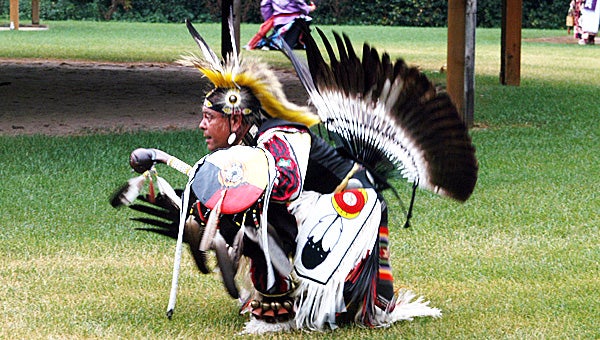Pokagon Band shares culture with students
Published 8:49 pm Thursday, September 19, 2013
Pokagon Band of Potawatomi Tribal Vice Chairman Bob Moody playfully asked busloads of Dowagiac and Niles students arrayed around the Rodgers Lake pow wow arena Thursday if they knew Indians still hunt for their food.
“We do,” he insisted. “We go to the grocery store and walk up and down the aisles and hunt for everything we have to get, just like you. But we also like to eat natural things, like wild rice, things out of lakes and streams and wild animals — venison, elk, rabbit and buffalo.”
Moody also explained his regalia and why Native Americans are sensitive to calling their colorful outfits “costumes.”
Costumes are worn on Halloween by people “pretending to be something they’re not, like a princess or Batman, to fill a bag with candy,” Master of Ceremonies Jason Wesaw explained. “These dancers are not pretending. That’s who they are on the inside. What they wear represents things from their family, from their dreams and from their heart.”
Moody said, “When you go somewhere special, you dress in your best clothes, which have been passed down from generation to generation. White bone on my chest would have protected me a long time ago if I got attacked. Same thing with the bound I wear around my neck if a knife was put to it. What I wear on my head is a porcupine hair roach. Not the quills, but the hair, sewn together, with an eagle feather on top. Bright colors, some are family, some are clan. They all tell a story about my life.”
A deluge of rain was part of the second annual Pokagon Heritage and Education Day, which helps dispel stereotypes.
“There are people here within the tribe who can be resources for your teachers. We want you to know the truth about our culture,” Wesaw said. “Our people have been here for generations and generations, thousands of years. We want you to feel welcome here and to bring some good knowledge back to your families. Today, you can take pictures any time you want.”
At pow wows, restrictions usually include Grand Entries when dancers enter the arena from the east; flag songs, honor songs; and when eagle feathers are being retrieved.
A girl asks, “Where do you sleep?”
“In wigwams a long time ago,” Wesaw, a ceramic artist, replied. “Now I have a cozy queen-sized bed inside my house, which has heat, lights, a refrigerator and a little dog. She meant ‘a long time ago,’ like in the 1980s. We live the same way you guys live. We love going to the movies, we have our favorite restaurants. Cell phones, Facebook, computer games, Xbox. Many kids in the tribe go to school with you, but we also follow old ways.”
Six hundred students from three communities experienced tribal language and culture last year. This year’s participating schools included third, fifth and seventh graders from Dowagiac Middle School, Justus Gage, Kincheloe, Patrick Hamilton and Sister Lakes elementary schools and Eastside Connections in Niles.
Students learned about different kinds of dance, such from jingle dress to fancy.
Female jingle dancers wear cloth dresses containing 365 small metal cones — a prayer for each day of the year. Cones are usually arrayed in seven rows — one for each of the great seven traditional teachings.
Male fancy dance is based on traditional warrior society and evolved into competitions for modern warriors. Dancers express themselves with intricate footwork, spins and colorful regalia, including two colorful feather bustles and extensive beadwork.
Female fancy shawl dance is thought to have originated as the butterfly dance. When her mate dies in battle, the female butterfly mourns and goes into a cocoon, symbolized by the shawl. She travels across the world, searching for happiness, stepping on every rock until she finds beauty in one.
Her regalia consists of a colorful shawl worn around her shoulders and a cloth dress with bright, intricate beadwork.
Traditional male and female dancers preserve the oldest style of Native American dancing. Male dancers act out feats of bravery with storytelling movements, imitating animals as they move from side to side.
Female traditional dancers wear buckskin or cloth dresses. Buckskin dresses with long, flowing fringes represent a waterfall and are decorated with bright, intricate beadwork. Women dancers drape shawls on their arms entering the sacred circle to symbolize they are always ready to care for their family.
Thursday’s events and Saturday’s citizens- and staff-only activities also celebrate “Sovereignty Day,” the 19th anniversary of Congress restoring the Pokagon Band’s federal recognition signed into law by President Bill Clinton on Sept. 21, 1994, after decades of struggle.
Federal recognition means the U.S. government recognizes the sovereignty of a tribal nation and confirms the government-to-government relationship between the two nations, acknowledging the right of the tribe to govern itself as it had before European and American immigration.
An 11-member Tribal Council is elected to staggered three-year terms to govern.
The Pokagon Band, based southwest of Dowagiac on Sink Road, with a second office in South Bend, Ind., exercises jurisdiction over its citizens and its tribal lands, maintains independent tribal courts and a police department and regulates its natural resources.
When American settlers first came to southwestern Michigan, Potawatomi leader Leopold Pokagon’s villagers lived in what is now Bertrand Township, Berrien County.
The 1833 Treaty of Chicago established conditions for westward removal.
Pokagon’s small band negotiated the right to remain in their homeland, partly because of a demonstrated attachment to Catholicism.
This connection was illustrated with the founding of the University of Notre Dame. Fr. Stephen Badin ministered to the Potawatomi before the mission moved to South Bend.
In 1838, Leopold Pokagon purchased land for his village in Silver Creek Township, Cass County, and moved his people to the Sister Lakes area.
As the Indian Removal Act played out, Potawatomi from northern Indiana and Michigan sought refuge. Descendants of this group number 4,500 citizens today.
Their homeland encompasses six counties — LaPorte, St. Joseph, Elkhart, Starke, Marshall and Kosciusko in Indiana and Cass, Berrien, Van Buren and Allegan in southwest Michigan.
The Pokagon Band is Indiana’s only federally-recognized tribe and one of 12 in Michigan. Offices closed Friday for Sovereignty Day.







